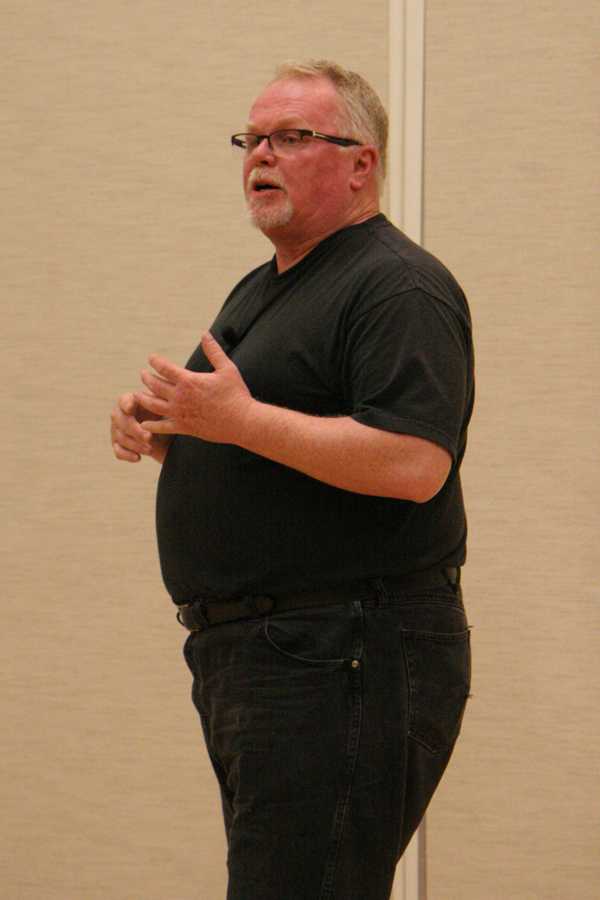Imagine being imprisoned for nine years, two of them on death row for a crime you didn’t commit.
Philadelphia native and honorably discharged former Marine, Kirk Bloodsworth, 52, said if it could happen to him, it can happen to anyone.
In 1984, Bloodsworth was convicted in the case of 9 year-old Dawn Hamilton who had been raped and murdered in Baltimore County, Maryland. Bloodsworth was labeled as the last person seen with Hamilton.
Hamilton was at a sleepover with her friends playing hide and seek in the woods. Hamilton was ‘it.’ She’d looked for her friends, but couldn’t find them. She found two boys, also her friends, fishing. She asked if they would help her find her friends, they refused.
Then, a man appeared over the hill and told Hamilton he’d help her. That was the last anyone had seen her.
Hamilton’s friends came back. She did not. She was found dead in a pile of leaves. Her murderer had assaulted her with a stick in her vagina and left her underwear, semen soaked, hanging from a tree.
Bloodworth was living in Baltimore County for a month as a commercial fisherman when police knocked on his door and said he was a suspect in the case of Hamilton’s rape and murder.
Speaking with his lawyer through glass partitioned telephone mirrors, Bloodsworth’s lawyer told him, “Kirk, you’re in a lot of trouble. But I know my way around the criminal justice system. We’re going to find our way out of here together.”
“He turned around and ran into a brick wall,” Bloodsworth said. “I thought, ‘Yeah, I’m in trouble.’”
In the court room, Bloodsworth received snarls and glares from the jury promising his death.
“‘Don’t be fooled by Bloodsworth,’ they all said, ‘he’s a monster in disguise,’” Bloodsworth said. “No one wanted to hear what I had to say.”
Bloodsworth’s alibi during the time of Hamilton’s murder was that he had taken the day off of work and he was at home with his wife at the time and his friends, they were all witnesses to Bloodworth’s innocence.
Yet, Bloodsworth’s trial was falling apart.
One of the boys at the pond saw Bloodsworth in the criminal line-up and told police his hair was too red. The perpetrator was described as being 6’5” with curly blonde hair and a tan. Police dismissed the boy’s statement.
“I was being questioned about the rape and murder of a 9 year-old girl,” Bloodsworth said. “Of course I was nervous! But really when I was sitting there being questioned, I had an ounce of pot in my shoe. I was nervous because I didn’t want them to take my weed.”
There was no physical evidence against Bloodsworth in Hamilton’s case. His biggest contenders were the “eyewitness” accounts and the composite sketch of the murderer.
“When that gavel came down and I was sentenced to death, that was it” Bloodsworth said. “My family was outraged and devastated. ‘Give him the gas and kick his ass,’ they all said. They partied until 4 a.m. for my arrest.”
Bloodsworth went on to spend nine years in the Maryland State Penitentiary.
“Most nights I had to sleep with toilet paper in my ears so cockroaches wouldn’t lay eggs inside of them,” Bloodsworth said.
Reading helped Bloodsworth through his imprisonment and a friend he had met called ‘Blue.’
“He’d been there for 25 years,” Bloodsworth said. “Blue was known as the toughest guy in the joint. He was caught for robbing multiple banks. But Blue was a gentle spirit. He taught me how to play chess. We ‘d talk about philosophy and life. He told me, ‘Bloodzy, you’re the most innocent man I ever met. You gotta get out of here.’”
Bloodsworth said they hoped to play chess one day as free men.
“One day, Blue came up to me and said ‘I’m getting out of here today!’” Bloodsworth said. “I knew he wasn’t going home. Then I see him dressing up in a suit and tie, he holds out two sharpened pencils and shoves them in his eyes. He said, ‘I don’t want to see it all anymore!’ He was doing life without parole in the dark.”
Meanwhile, Bloodsworth’s days were numbered. He spent his time working as a prison librarian.
“We’re going to get you for what you did to that girl,” Bloodsworth said. “That’s all I could hear echoing through my head through the tears.”
There was word of a new suspect in Bloodsworth’s case. The court gave him a new trial.
“I was convicted twice as an innocent man,” Bloodsworth said.
He signed his letters to friends and family members as ‘the honorable Kirk Bloodsworth A.I.M. (an innocent man).’
The moment that opened Bloodsworth eyes, he said, came when a guard delivered a stack of books addressed to him. One book, “The Blooding,” by Joseph Wambaugh, was about a man who was convicted from DNA testing.
“If someone can be convicted from DNA, someone can be freed,” Bloodsworth said.
He worked on his case day and night trying to find DNA evidence. He’d gotten a letter back saying, ‘We regret to inform you that any traces of DNA from your case had been destroyed.’
“I threw everything everywhere,” Bloodsworth said.
Days, weeks, months, and years passed with Bloodsworth continuing to work on his case. Bloodsworth’s day of reckoning had arrived.
Returning back to the Towson courtroom in Maryland, Hamilton’s panties were found in a paper bag on the floor of the judge’s chambers. The DNA was tested. The criminal, Kimberly Shay Ruffner, had been found.
“He slept a tier below me in prison and never said a word,” Bloodsworth said. “Anytime he checked out a book from the library he always avoided eye contact with me.”
The most emotional thing for Bloodsworth to deal with during his imprisonment was the death of his mother.
“She had passed away five months before I was released,” Bloodsworth said. “I could see her at her funeral for five minutes in my chains, handcuffs, and shackles.”
Bloodsworth’s mother always told him to stand up for himself.
“She always said, ‘Don’t sit there like a bump on a dill pickle,’” Bloodsworth said.
After Bloodsworth’s innocence, many others were being let out of prison from DNA evidence testing.
“When I got the call saying they had the DNA test, they told me not to tell anyone,” Bloodsworth said. “I called everyone!”
Hamilton’s father later apologized to Bloodsworth for what happened to him.
“I told him there was nothing for him to be sorry for,” Bloodsworth said. “I wanted peace for both of us.”
Bloodsworth received $300,000 dollars from the government to apologize for his imprisonment, amounting to $3.72 an hour while he was in jail.
The hardest part about getting back into society, Bloodsworth said, was dating.
“One woman asked me, ‘Where ‘ve you been for the past 9 years?’ ‘In jail,’ I told her. ‘But I didn’t do it. Can you pass the salt?’”
The man that should have been ‘put to death by lethal gas’ abolished the death penalty in the state of Maryland is looking to do so in all 50 states through his organization, Witness to Innocence.
The moment starting the downward spiral in Bloodsworth’s case was when police showed his neighbor at the time the composite picture of Hamilton’s assailant, to which they said, “That kind of looks like my neighbor, Kirk.”
“You need to be absolutely sure in these situations,” Bloodsworth said.
Today, Bloodsworth is a free man, along with his friend Blue.
Bloodsworth gave advice to SRU students, “You must stand up for your friends, your school, everyone. You must stand up when things get rough. Because if it can happen to me, it can happen to you.”








